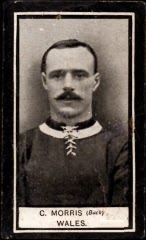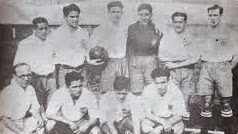Thomas Maley was an Irishman who served in the Royal Highland Fusiliers for 22 years. He was a veteran of the Crimea and had traveled the world. He had 4 sons. One,Charles,became a priest, the other 3 were involved in football.
Tom (1864 –1935)
Tom was born in Portsmouth. He was an all round athlete, particularly successful at the 100 yards. Unsurprisingly he played on the wing, as outside left. Known as Handsome Tom, he played football as an amateur, being a qualified school master.
Tom played in Celtic's first ever match , and when his playing days were over he became a director of the club (1897).
In 1902 Tom took over as manager of Manchester City. Maley's time at City got off to a tragic start. Welsh star Di Jones died as the result of an injury sustained in an exhibition match. Tom Maley was influential though in creating a strong bond between his players. They won promotion back to the First Division in his first season in charge, and the following season (1903–04) they won the FA Cup and finished 2nd in the League. 1904–05 saw City finishing in 3rd place and 1905-06 5th. Maley was transforming City into a major force.
Manchester City's record under Maley:
P | W | D | L | F | A | Win % |
150 | 89 | 22 | 39 | 322 | 178 | 59.33 |
However in the summer of 1906 an FA investigation into the payment of bonuses had a catastrophic impact on the club. 17 players were fined and suspended from football until January 1907 . City had to sell many players and Maley received a life ban from the game.
He returned to Glasgow and worked as a teacher, When his life ban was revoked in 1910 he returned to football management.
As a player: |
1881 | Cathcart |
1882 | London Caledonian |
1883 | Partick Thistle |
1884 | Third Lanark Rifle Volunteers |
1885 | Hibernian |
1886 | Third Lanark Rifle Volunteers |
1887 | Clydesdale Harriers |
1888- 1891 | Celtic |
1891 | St Mirren (loan) |
1892-93 | Preston North End |
|
|
As manager: |
1902 | Manchester City |
1911 | Bradford Park Avenue |
1925 | Southport |
1931 | Celtic (assistant) |
Willie (1868 –1958)
Willie was born in Newry in Ireland. Like Tom, he developed into an all round athlete. His incredible association with Celtic began by chance. Brother Walfrid and Mr Glass were calling on Tom Maley in Cathcart to ask him to join the club they were forming. Tom was out, Willie was at home. They suggested that if Tom decided to take up the offer that Willie should come along as well.
Consequently Willie played alongside Tom in Celtic's first ever fixture.
Playing at half-back Willie was at Celtic for 9 seasons as a player, winning 3 Scottish League Championships (1892-93, 1893-94, 1895-96) and the Scottish FA Cup (1892). He made 2 international appearances for Scotland in 1893.
Maley had his first taste of football administration when he took on the role of Player-Secretary in May 1894. Maley became full-time manager of Celtic at the end of the 1897 season. He remained in post for 43 years, during which time he led the club to 30 trophy wins.
As a player: |
1886 | Cathcart Hazlebank |
1887 | Third Lanark Rifle Volunteers |
1888-97 | Celtic |
1889 | Ardwick (loan) |
1893 | Scotland (2 internationals) |
1895-96 | Manchester City (loan) |
1896-97 | Everton (loan) |
|
|
As manager: |
1897- 1940 | Celtic |
| League | Cup |
1897–98 | Champions |
|
1898–99 |
| Winners |
1899–1900 |
| Winners |
1900-01 |
|
|
1901-02 |
|
|
1902-03 |
|
|
1903–04 |
| Winners |
1904–05 | Champions |
|
1905–06 | Champions |
|
1906–07 | Champions | Winners |
1907–08 | Champions | Winners |
1908–09 | Champions |
|
1909–10 | Champions |
|
1910–11 |
| Winners |
1911–12 |
| Winners |
1912-13 |
|
|
1913–14 | Champions | Winners |
1914–15 | Champions |
|
1915–16 | Champions |
|
1916–17 | Champions |
|
1917-18 |
|
|
1918–19 | Champions |
|
1919-20 |
|
|
1920-21 |
|
|
1921–22 | Champions |
|
1922–23 |
| Winners |
1923-24 |
|
|
1924-25 |
| Winners |
1925-26 | Champions |
|
1926-27 |
| Winners |
1927-28 |
|
|
1928-29 |
|
|
1929-30 |
|
|
1930-31 |
| Winners |
1931-32 |
|
|
1932-33 |
| Winners |
1933-34 |
|
|
1934-35 |
|
|
1935-36 | Champions |
|
1936-37 |
| Winners |
1937–38 | Champions |
|
Celtic's record under Maley:
One of the only pics I've seen of Willie Maley sans hat- in a hat advertisement.
Alex
(1874 – 1949)
Youngest brother Alex never played at a high level, but followed his brothers into management. He was, incidentally, the only one born in Scotland. He also worked as a journalist.
As manager:
1909–1912 | Clyde |
????–1921 | Clydebank |
1921–1925 | Hibernian |
1925–1927 | Crystal Palace |








.jpg)
.jpg)







.jpg)











.jpg)


.jpg)




.jpg)







